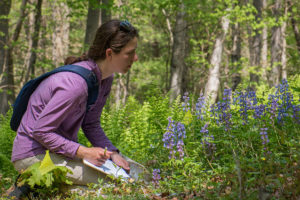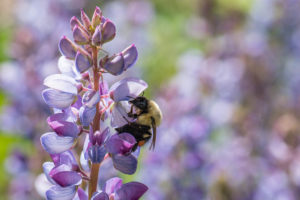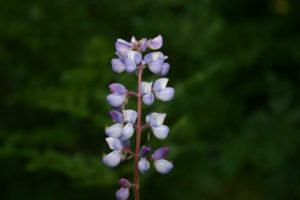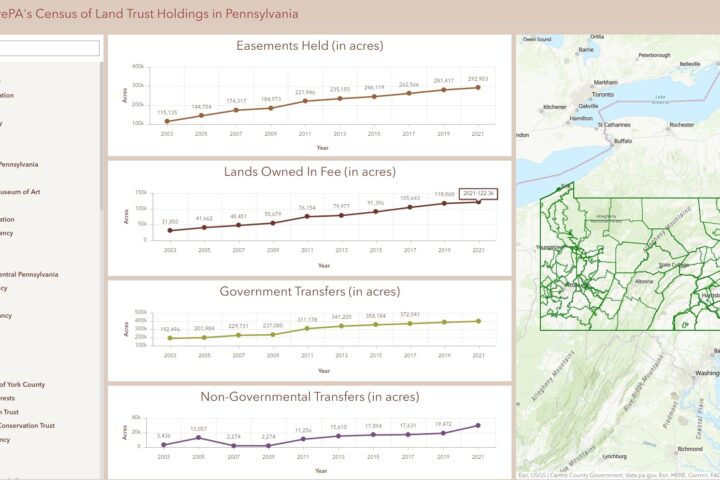
Research site visit by Nash Turley
By Karley Stasko, Director of Marketing & Development, North Branch Land Trust
On a late spring morning in a small field of stunning wildflowers, Isabella Petitta and her lab partner are keener on the insects zipping around from bud to bud. Bees of all shapes and sizes are sneaking into the blue shell-like blooms of the Lupinus perennis. The researchers had already measured the lupines, counted the blooms, and recorded the other flora thriving in the area. Now, they are watching the insects pollinating them. By November, they will be setting this same field on fire using a highly controlled protocol for safety. The researchers are from Penn State’s Ecology Department who traveled to Luzerne County to collect data from one of their six historical lupine population research sites. Their goal is to examine the effects of controlled burns and fencing on the restoration of lupine populations in Pennsylvania.

Lupine bee by Nash Turley
Lupines are a diverse genus of plants in the legume family with leaves divided into 7-11 leaflets arranged in a circle, tall inflorescences, and deep roots that prevent soil erosion, with most diversity occurring in North and South America. Unfortunately, the United States has seen a precipitous decline in wild lupine (Lupinus perennis) with estimates of 90% population loss in the last century. This plant is an important host to native butterflies, including Frosted Elfins, Dusky Wings, and the endangered Karner blue. While habitat destruction and fragmentation are the biggest threats to these plants, the problem that this research team is examining happens to be a lack of wildfires. “In a strange way, we’ve just gotten too good at stopping fires,” Isabella said. Lupine beans are incredibly tough, and those seeds often need to be roughed up for germination success. Isabella noted that there are a variety of natural and unnatural ways to disturb the seeds for germination being investigated, yet mowing, allowing ungulates to graze, or encouraging wildfires to burn for a time are not part of what traditionally comes to mind when we think of habitat restoration.
Isabella was preparing for her Graduate Program at Penn State when she became involved in this project. “In the past, one of my co-advisors, Autumn Sabo, had worked with lupines in Wisconsin and my other co-advisor Margarita López-Uribe, is an expert in wild bee ecology and evolution. From there the research team developed with a variety of specializations including Forestry, Botany, Entomology, and Genetics. And collectively, with the other organizations involved, we had all the knowledge to investigate the lupine system.” Isabella’s specialty is entomology. Her undergraduate research examined the diversity of bee populations in soybeans. “First soybeans, now lupine. I’ve stuck with legumes!” she laughed. However, their project is part of a much larger interest aimed at preserving wild lupine in Pennsylvania. Isabella noted that one of their project partners, the Pennsylvania Department of Conservation and Natural Resources (DCNR), has been deeply engaged in researching the decline and repopulation of lupines for more than a decade, but this is the first broad experimental study of this nature in Pennsylvania. It was through the DCNR that the Penn State team became connected to North Branch Land Trust and the Luzerne County site became one of six to be studied over the course of the next few seasons. In addition to North Branch Land Trust and the DCNR, the Pennsylvania Bureau of Forestry, and the Nature Conservancy will also be assisting with controlled burns that will be occurring in the autumn.

Lupine by NBLT Staff
How could forest fires help the environment? Sydney, a Penn State graduate student assisting with the project, explained, “Imagine a small forest fire with no human development or interference. Let’s say most of the trees are old and because of that, the understory is shaded and not a lot of new trees can grow. And because the trees are old or sick, they catch fire quickly, and the former forest ends up covered in ash. The ash not only contains the nutrients that were in the trees that burned, but it also can help balance out the pH of the soil. Then, since the ground is no longer shady, herbaceous plants like lupines flourish. Lupines specifically fix nitrogen in the soil, a nutrient necessary for optimal plant growth. Eventually, the ground starts to support large trees again, and the forest comes back. This would have happened in mosaic and over the course of decades in a cycle of meadow and forest. But like Isabella said, we’ve gotten too good at stopping all forest fires and keeping trees that are sick, injured, or dying on life support instead of encouraging new growth.” Fringe habitats with a variety of light and shade are vital to the development of many invertebrate species.
But even before the autumnal burns, these researchers have learned plenty about Pennsylvania’s lupine populations and a variety of variables that could confound their data. Isabella said, “We are collecting data on the plants themselves, height, number of flowers, number and health of seeds, and even collecting leaves from out-of-state populations for a genetic study. That way we can trace through the DNA how far pollinators and seed carriers might be transporting genetic materials or if these populations are inbreeding through self-pollination.”
Sydney noted how and why self-pollination becomes an issue. “When you have habitats that are too far apart for pollinators or for seeds to travel, those plants are inbreeding in only a few generations. Less genetic variety means that a disease or pest that harms one plant is more likely to affect that whole population. Conversely, greater geneflow between populations could mean better, or at least more diverse resistances.” The women had also gathered data on leaf litter depth, light, shade, soil quality, neighboring plants, and, Isabella’s specialty, insects.
“We are really excited about what we are seeing with the pollinators, especially the Karner, since they are so dependent on these habitats.” The Karner blue butterfly, first described by poet, novelist, and entomologist Vladimir Nabokov in 1944, was classified as endangered by 1992. Yet, Isabella was most interested in the bees. Many native bees, including various ground and sweat bees, are generalists, which means they gather from any flower source available to them. Isabella noticed larger, more dense populations of bees from the Osmia genus. Bees have special hairs for collecting pollen called scopa, and while most bees have hair on their legs, Osmia have fuzzy abdomens. “When they enter the shell-like flower, the anthers with pollen are pointing upwards, and so the pollen ends up on the underside of the bee. It’s possible that Osmia are lupine specialists based on the location of these hairs.” I asked if the team is one of the first to consider the direct relationship between lupines and Osmia. Isabella hesitated, “It’s not something that we have found highly reported in existing literature related to lupines, but this genus is known to specialist on the plant family Fabaceae.” Incredibly modest, but the truth is this sort of integrated approach considering entomology, genetics, and other fields in addition to a botanist’s expertise allows this study to consider a much wider scope of variables than it had in the past.
As with many North Branch Land Trust Conservation Easements, the area currently being studied is privately owned and, as such, not publicly accessible. Regardless, protecting even the most inaccessible habitats with meaningful research-based management can inform best practices that improve the overall health of Pennsylvania’s natural resources. North Branch Land Trust will continue to check in on the Penn State Lupine Research team in the coming months to uncover more about what they have learned and what we can do in our own backyards to conserve the lands we hold dear.



